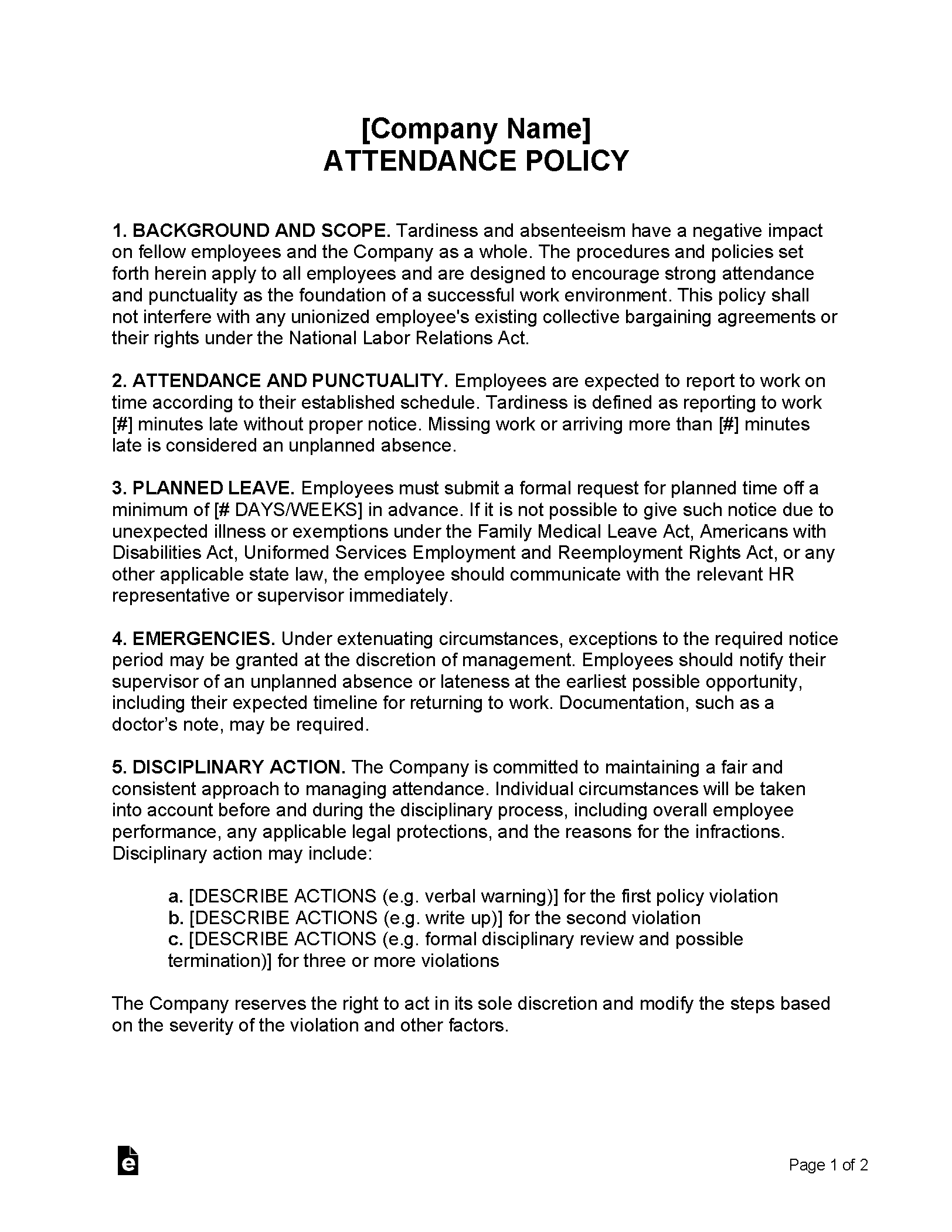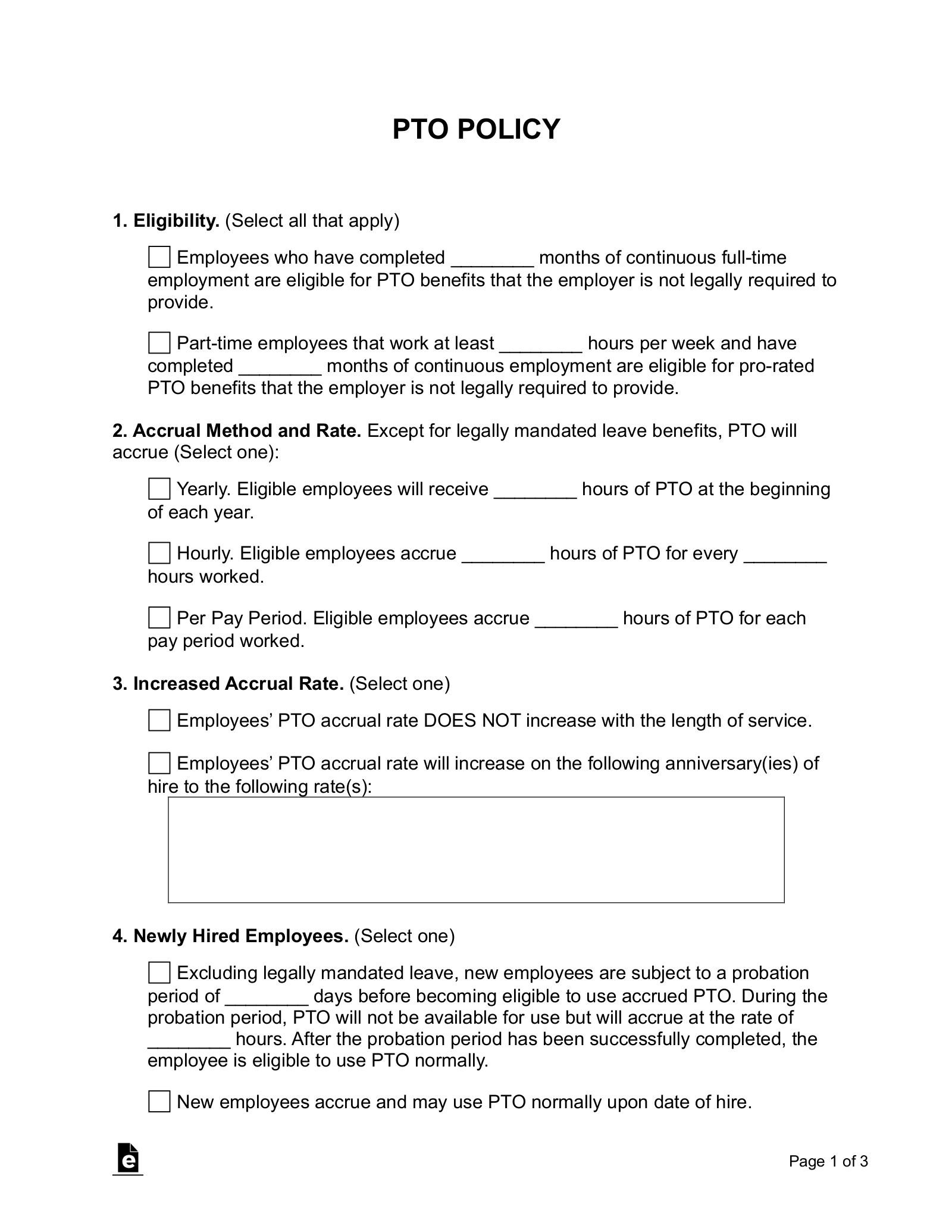Updated September 27, 2023
An employment policy clarifies the rights and responsibilities of employers and employees within a company or organization. The intent of an employment policy is to create a positive working environment, reduce the possibility of conflict in the workplace, and guide and ensure a company’s compliance with federal, state, and local regulations.
Employment Policies Typically Cover:
- Recruitment
- Compensation
- Health benefits
- Vacation and sick time
- Absences
- Retirement packages
- Disciplinary action
Table of Contents |
Employment Policies: By Type (3)
 Attendance – Formalizes an employer’s expectations regarding an employee’s attendance.
Attendance – Formalizes an employer’s expectations regarding an employee’s attendance.
Download: PDF, MS Word, Open Document
 Bereavement – Sets forth a company’s policy on employees taking paid or unpaid time off following the death of a family member.
Bereavement – Sets forth a company’s policy on employees taking paid or unpaid time off following the death of a family member.
Download: PDF, MS Word, Open Document
 PTO – PTO refers to Paid Time Off, and a PTO policy defines how and when an employee may take time off while still getting paid.
PTO – PTO refers to Paid Time Off, and a PTO policy defines how and when an employee may take time off while still getting paid.
Download: PDF, MS Word, Open Document
What is an Employment Policy?
An employment policy establishes an organization’s purpose, explains how employers and employees are expected to conduct themselves, and outlines what steps will be taken in the event of a violation of the stated rules. They differ from company to company because they reflect an organization’s specific objectives, values, and culture.
The International Labor Organization (ILO) designates states to implement national employment policies. While the United States is one of 59 countries that lacks a national employment policy,[1] various federal laws do address employment and should be integrated into company policies. These include:
- Fair Labor Standards Act (FLSA): Establishes standards for minimum wage, overtime pay, recordkeeping, and youth employment.[2] (See the guides to understanding the FLSA.)
- Title VII of the Civil Rights Act: Requires employers to establish policies that prohibit discrimination and harassment and ensure equal opportunities.[3]
- Americans with Disabilities Act (ADA): Prohibits discrimination against people with disabilities.[4]
- Family and Medical Leave Act (FMLA): Eligible employees are granted leave for specific reasons, including childbirth and serious illness and more.[5]
- Occupational Safety and Health Act (OSHA): Monitors and maintains workplace safety. Covers issues such as noise, chemicals, and hygiene.[6]
- Employee Retirement Income Security Act (ERISA): Sets minimum standards for retirement and health plans.[7] (See the guides for compliance with ERISA.)
Are They Required?
While no single statute requires employers in the United States to implement employment policies, federal laws do require employers to address certain aspects of employment in some kind of clear, widely circulated policy document.
Can an Employer Change a Policy Without Notice?
Changing employee policies depends on factors that include the laws where the company is located and whether the proposed change considerably affects employees’ working conditions or rights. Some regulations may require employers to give notice, or they may be required to take steps before making changes.
What to Include
Purpose Statement
This section clarifies a company’s mission statement, backstory, goals, values, and beliefs. The employment policy will become part of the company’s onboarding process and a new employee’s means of becoming familiar with the company’s vision and operating procedures, so it’s important to think about addressing the company’s stance on such matters as discrimination, leadership, communication, and discipline.
Specifications
This section addresses the specifics of the policy and might address such matters as:
- Onboarding
- Code of conduct (e.g. dress code, behavior, substance abuse)
- Disciplinary action
- Working hours and attendance
- Working conditions
- Compensation
- Use of company property
- Data privacy
- Travel and expense reimbursement
- Benefits (e.g. PTO, retirement, healthcare)
- Bereavement leave
- Performance reviews
- Termination
Anti-Discrimination
The U.S. Department of Labor, per the FLSA, requires employers to post notice of their commitment to ensuring equal opportunity among all people. The act prohibits employers from discriminating based on age, race, disability, religion, sex, sexual orientation, parental status, and/or marital status.
Anti-discrimination policy applies to how jobs are advertised, employees are recruited, hiring decisions are made, jobs are assigned, employees are paid, and resignations are handled.
Implementation
An employment policy should identify consequences for violating its terms and outline the precise methods by which disciplinary action will be taken, as well as who will take them.
Different Policies for Different Workplaces
Different types of companies will need to incorporate different types of issues in their employment policies. Below are some examples of issues some companies may need to consider addressing while developing a policy.
Remote and Flexible Work
A study by Stanford University and the United States Census Bureau indicates that in the United States, remote work now accounts for over a quarter of paid full-time workdays.[8] Companies that allow their employees to work remotely are advised to delineate the terms of their remote working arrangements in an employment policy.
Some issues to consider include:
- Whether employees should keep specific hours
- Expectations for communication and availability
- Requirements for a remote workspace (e.g., internet connectivity, relevant software)
- Data security and encryption
- Reimbursement for work-related costs
- Performance management
- Cybersecurity
Drug Testing
Here are some examples of industries that generally require employees to take periodic drug tests:
- Aviation
- Trucking
- Oil and gas
- Construction
- Law enforcement
- Healthcare
- Defense
- Sports
A drug testing policy should outline testing methods, consequences for refusing to take a test, and what happens when an employee tests positive for substances deemed off-limits.
Social Media
A typical social media policy outlines how and when employees can use social media during work hours. These policies may also restrict employees from sharing certain kinds of information on their personal accounts.
Cybersecurity
Companies that handle sensitive data should include cybersecurity in their employment policy. Examples include:
- Technology companies
- Financial institutions
- Healthcare providers
- Government agencies
- Educational institutions
- Professional services firms (e.g. law, accounting)
- Manufacturing companies
- Nonprofit organizations
A cybersecurity policy should address password requirements, email security measures, rules for handling data and technology, and how cybersecurity breaches and incidents will be handled.
How to Implement
- Develop/Review: An employment policy, once developed, should be reviewed and approved by senior managers. When the document is approved, it should be clearly communicated to all employees.
- Communicate: If circulated via email, the policy should stand out as important. It’s also a good idea to include some way for the employee to formally acknowledge receipt of the policy.
- Train: Some companies have training sessions focused on the new policy to ensure all employees thoroughly understand its tenets. The policy should also be incorporated into the onboarding process.
- Monitor: A designated individual or department should be responsible for monitoring compliance with the policy, which should be consistently enforced.
- Revisit: An employment policy should also be reviewed and updated regularly. The Society for Human Resource Management (SHRM) suggests reviewing at least annually.[9]
Sources
- ILO Overview of National Employment Policies
- Fair Labor Standards Act (FLSA)
- Title VII of the Civil Rights Act
- Americans with Disabilities Act (ADA)
- Family and Medical Leave Act (FMLA)
- Occupational Safety and Health Act (OSHA)
- Employee Retirement Income Security Act (ERISA)
- Survey of Working Arrangements and Attitudes – May 2023 Updates
- SHRM Guide – How to Develop and Implement a New Company Policy
